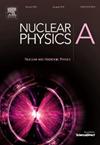Characterizing nuclear pasta with alpha shapes
IF 2.5
4区 物理与天体物理
Q2 PHYSICS, NUCLEAR
引用次数: 0
Abstract
Nuclear pasta structures, which emerge in large nucleon systems at subsaturation densities and near-zero temperatures, have traditionally been analyzed using Minkowski Functionals, particularly through the correlation between Curvature and Euler Characteristic. Previous methods relied on cubic voxelization to create three-dimensional bodies from nuclear theory data points, leading to inaccurate estimations of geometric properties. This work introduces the alpha shapes method as a superior alternative for constructing three-dimensional solid bodies from point cloud data and calculating Minkowski Functionals. Through test cases comparing voxelization and alpha shapes, as well as analysis of pasta structures obtained through classical molecular dynamics, we demonstrate that the alpha shapes method provides more accurate geometric representations and simplifies the calculation of Minkowski Functionals. We use Diode, a Python library implementing alpha shape calculations, to verify previously observed correlations between pasta shapes and their position in the Curvature-Euler Characteristic plane. Our analysis, extending across various temperatures and densities, reveals a density-dependent trend in pasta shapes that is relatively temperature-independent. The method is also tested satisfactorily with neutron star matter. These findings provide a quantitative framework for characterizing the evolution of nuclear pasta structures and offer a new computational tool for researchers studying these phenomena through different theoretical approaches.
用α形状表征核面食
在亚饱和密度和接近零温度的大型核子系统中出现的核面食结构,传统上使用闵可夫斯基泛函进行分析,特别是通过曲率和欧拉特性之间的相关性。以前的方法依靠立方体素化从核理论数据点创建三维物体,导致对几何性质的不准确估计。这项工作介绍了alpha形状方法作为从点云数据构建三维实体和计算闵可夫斯基泛函的优越选择。通过体素化和alpha形状的对比测试用例,以及对经典分子动力学得到的面食结构的分析,我们证明了alpha形状方法提供了更精确的几何表示,简化了Minkowski泛函的计算。我们使用二极管,一个实现alpha形状计算的Python库,来验证之前观察到的面食形状和它们在曲率-欧拉特征平面上的位置之间的相关性。我们的分析跨越了不同的温度和密度,揭示了意大利面形状的密度依赖趋势,而这种趋势与温度相对无关。该方法在中子星物质中也得到了满意的验证。这些发现为表征核面食结构的演变提供了定量框架,并为研究人员通过不同的理论方法研究这些现象提供了新的计算工具。
本文章由计算机程序翻译,如有差异,请以英文原文为准。
求助全文
约1分钟内获得全文
求助全文
来源期刊

Nuclear Physics A
物理-物理:核物理
CiteScore
3.60
自引率
7.10%
发文量
113
审稿时长
61 days
期刊介绍:
Nuclear Physics A focuses on the domain of nuclear and hadronic physics and includes the following subsections: Nuclear Structure and Dynamics; Intermediate and High Energy Heavy Ion Physics; Hadronic Physics; Electromagnetic and Weak Interactions; Nuclear Astrophysics. The emphasis is on original research papers. A number of carefully selected and reviewed conference proceedings are published as an integral part of the journal.
 求助内容:
求助内容: 应助结果提醒方式:
应助结果提醒方式:


